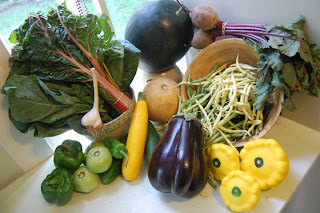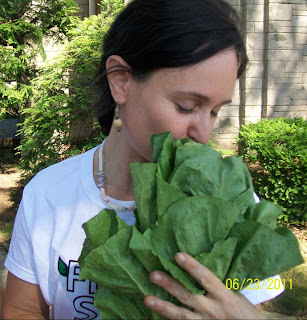Don Tyler hard at work at the Shawnee Neighborhood Fresh Stop
My friend and her daughter have been tutoring one of the three children and helping the family work through the maze of life here in the USA. The mother of the family (let's call them the Jafarris) told my friend that in just two years here in Kentucky, she has gained a considerable amount of weight, and her children are eating a lot of sugar and salty snacks, and are refusing to eat most vegetables. Since arriving in Louisville, they have had to participate in the "system" in order to afford to eat and exist: SNAP Benefits, WIC, Medicaid, etc. The irony of this, as many of us know, is that these federal subsidies often encourage unhealthy eating and life styles. For example, WIC subsidies pay for sugary cereals, conventional cheese, sweet juices, etc. Only $10 of WIC subsidies can be used to purchase fresh produce. Refugees see their fellow Louisvillians buying up the snacks and soft drinks with their SNAP Benefits, and the cheap, easy calories might even become a signpost to these families that they are finally becoming American. Diet-related illnesses, unfortunately, often follow, and then the doctors they see, not knowing or asking the family their food stories, will often prescribe meds, then more sickness, more meds....you know the story.
We brought the Jafarris over a produce basket share from the Shawnee Neighborhood Fresh Stop. The week's share was collard greens, kale, pumpkin, acorn squash, sweet potatoes, green beans, tomatoes, pumpkin, lettuce greens, etc.
One could of course make the assumption that this family was unfamiliar with most of this local produce. However, my instincts and years on the ground have taught me that opening up the discussion to try and understand each person's individual food story is the very first step toward economic justice and equality. Never should we ever make the assumption that we know more than another adult just because we might have more education, more life experience, live in a better neighborhood, and G-d forbid, have a lighter skin tone. But this is exactly what I see and hear all over the City as I talk about our work at New Roots: "We just have to educate THEM." "THEY don't really know how or want to eat produce, we have to teach them," etc. However, time and time again, I learn that if I simply ask questions of people and listen, I am always happy to learn that, actually, the tables are usually turned. I walk away learning more than they did.
But back to my story. As we slowly started to lift the produce out of the boxes, I asked Mrs. Jafarri if she knew what the vegetable was, or if not, I tried to compare it to some similar vegetable she might have seen in the Middle East (it helps that I have traveled to the Middle East and I am familiar with the cuisine). For example:
"Do you know what this is?" (Me, holding up some good 'ole southern collard greens).
"Yes, we make dolmehs with them. We stuff them with rice and herbs." (Ms. Jafarri).
"Oh, yes dolmehs! So you don't only use grape leaves for dolmeh's?" (Me).
"No, we use these also." (Ms. Jafarri).
Some of the vegetables were not that familiar to the family. For example, acorn squash. My friend took this squash home, and cooked up some awesome squash soup and brought it back over. She also engaged the children in cutting up some sweet potatoes for fries. Smiling faces all around.
HA! Stuffed collard greens! Suddenly it dawned on me that the refugee population are in fact, creative and important participants in rebuilding our local food system and cuisine. A whole world opened up to me. Suddenly I started to think about all the possibilities for us here in Louisville, and the cross-cultural dialogue that can happen—that must happen—around refugees and our local food system. I have been connected to Catholic Charities Refugee Agricultural Partnership Program for many years. It is a great program that helps refugees who might have been farming in their native lands, learn how to farm in Kentucky, and either make a living out of their work, or provide food for their families and friends. However, what I am thinking about is reaching more of the families who did not farm back home, who don't have the time to farm and/or seek out farmers' markets (that are often way too expensive for them, unfortunately), and want to eat local.
I would love to create a Fresh Stop that includes refugees and other families, bringing groups of people together who would normally never cross paths, to collectively raise our food and health IQ. Anyone interested?
Stuffed Collard Dolmehs with Grassfed Beef, Rice and Peas
-->
Ingredients (20-30 Grape Leaves):
30-40 Collard Green Leaves—you will need extra leaves to line the bottom of the pot
1 cup rice
1 medium onion
1/2 cup yellow split peas (lapeh)
1/3 cup lemon juice or vinegar
2-3 tablespoons sugar
1 lb of ground grass-fed beef
½ cup to 1 cup fresh or dry (or combination); these include parsley, cilantro, green onions, mint and savory leaves, and a small amount of tarragon.
salt, pepper
turmeric (your preference; I added 1 TBS)
olive oil
water
30-40 Collard Green Leaves—you will need extra leaves to line the bottom of the pot
1 cup rice
1 medium onion
1/2 cup yellow split peas (lapeh)
1/3 cup lemon juice or vinegar
2-3 tablespoons sugar
1 lb of ground grass-fed beef
½ cup to 1 cup fresh or dry (or combination); these include parsley, cilantro, green onions, mint and savory leaves, and a small amount of tarragon.
salt, pepper
turmeric (your preference; I added 1 TBS)
olive oil
water
Chop up the onion small and fry it in a
pan with a little olive oil. Add the meat once the onion is golden in color and
fry the meat. Add about half a cup of water and allow the meat to cook. You
will add salt, pepper, and turmeric to the meat as well. Allow the meat to cook
for at least 20. Once the meat is cooked set it aside and allow it to cool.
Heat up water in a pot and boil the
yellow split peas for approximately 25 minutes. Then drain and set them aside
to cool.
Heat up water in a pot and bring the
rice to a boil. Drain the rice and set aside to cool.
Clean any fresh herbs and chop them up
slightly using a food processor (or a knife). If using any dry herbs make sure
to use less than you would if using fresh herbs. Mix all these ingredients
together in a bowl, add salt and pepper for taste.
Carefully cut away stem from collard
leaves. Boil them in water for a few seconds so that they soft. Lift out with tongs
and lay out flat. Take the
leaves one at a time and lay them on a surface or cutting board. Take some of
the mixture and place it on the leaf and then begin wrapping the leaf up like a
little package, folding in first the top of the greens, then the sides, then
rolling them up till they are somewhat rectangular.
Add oil to the pot you plan on using to cook the Dolmeh in. Take a few leaves that aren’t wrapped and place them on the bottom of the pot. Take all the prepared Dolmeh’s and place them on the bottom of the pot leaving no spaces.Take the 1/3 cup of lemon juice (or vinegar) and add the sugar to it. Add about a cup of water to the juice/sugar and stir everything together. Once the sugar has dissolved pour the contents all over the Dolmeh’s in the pot.
Place a plate (or something else that’s
heavy) over the Dolmeh’s to make sure they don’t move around. Turn the burner
on to low heat and place the lid on top of the pot. Allow the Stuffed Grape Leaves
to cook for 30-45 minutes. Don’t let them burn! Enjoy warm, with a side of tahini, salad, etc.






